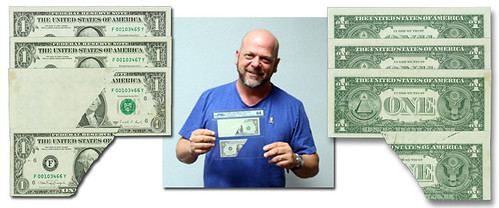
PREV ARTICLE
NEXT ARTICLE
FULL ISSUE
PREV FULL ISSUE
$1 BILL RETAINED OBSTRUCTION ERROR
I have a small collection of error U.S. $1 notes, but none like this. Currency Specialist Brad Ciociola published an article in the
August 8, 2015 Stack's Bowers E-Newsletter about an unusual "Retained Obstruction Error". In the image, there are three
consecutively numbered notes. The first two are normally printed. But the third had a trapezoid-shaped piece of paper on top of it during
the whole printing process. Neat! The Obstruction is the object that got in the way of printing; if you have that Obstruction in hand
it's a "Retained Obstruction Error". -Editor

One lot in our Stack’s Bowers Galleries Official Currency Auction of the ANA World’s Fair of Money stands out not only for its wild appearance but also for the famous pedigree that accompanies it. “At first look I thought this was a fake, it just seemed impossible.” That was Rick Harrison’s first impression of the incredible retained obstruction error $1 Federal Reserve Note offered as lot #40237 in next week’s auction. Harrison is the well-known owner of the Gold & Silver Pawn Shop in Las Vegas, Nevada, and the star of the History Channel’s hit reality series “Pawn Stars.” He consigned the incredible piece to Stack’s Bowers hoping that prospective bidders would be as wowed by incredible error as he was. The seemingly impossible error is the most dramatic retained obstruction error we’ve ever seen -- a Fr. 1915-F Series 1988A $1 Federal Reserve Note with an approximately 50% obstruction of the face printing affecting the entire left side of the note as well as a diagonal portion up through the portrait at the center of the note. The obstructing item is what makes the error especially fantastic, as it is a fragment of a note, of corresponding size to the obstruction, and features all three stages of a print run. That’s right, the retained item which caused the obstruction on the face of the host note not only displays a face printing but also a printed back and overprint on the face. While such an error is incredibly unlikely, seemingly impossible even, the circumstances of how it came to be can be explained. The obstructing fragment comes from a sheet prior to that of the host note. A misaligned first (back) printing on the fragment would indicate that a problem likely occurred when the sheet was fed into the printing press. Likely the misaligned sheet caused a jam when the sheet was flipped causing it to tear. Part of that torn sheet came back down onto the sheet of the host note which then went together through the second (face) and third (overprint) printings. They remained together for cutting and banding which allowed this astounding error to escape the production facility. It was eventually discovered and saved along with its corresponding bookend notes. Notable error note specialist Frederick Bart confirmed the process which resulted in the error and described the obstruction piece as “one of the most exciting error discoveries of the decade.” Bart further pointed out that there is no equally impressive obstruction error to be found in his soon to be released 4th edition of United States Paper Money Errors. To read the complete article, see:
Wayne Homren, Editor The Numismatic Bibliomania Society is a non-profit organization promoting numismatic literature. See our web site at coinbooks.org. To submit items for publication in The E-Sylum, write to the Editor at this address: whomren@gmail.com To subscribe go to: https://my.binhost.com/lists/listinfo/esylum All Rights Reserved. NBS Home Page Contact the NBS webmaster 
|